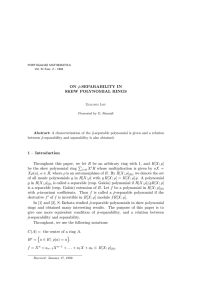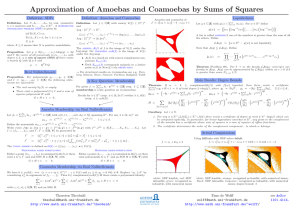Document 10447273
advertisement
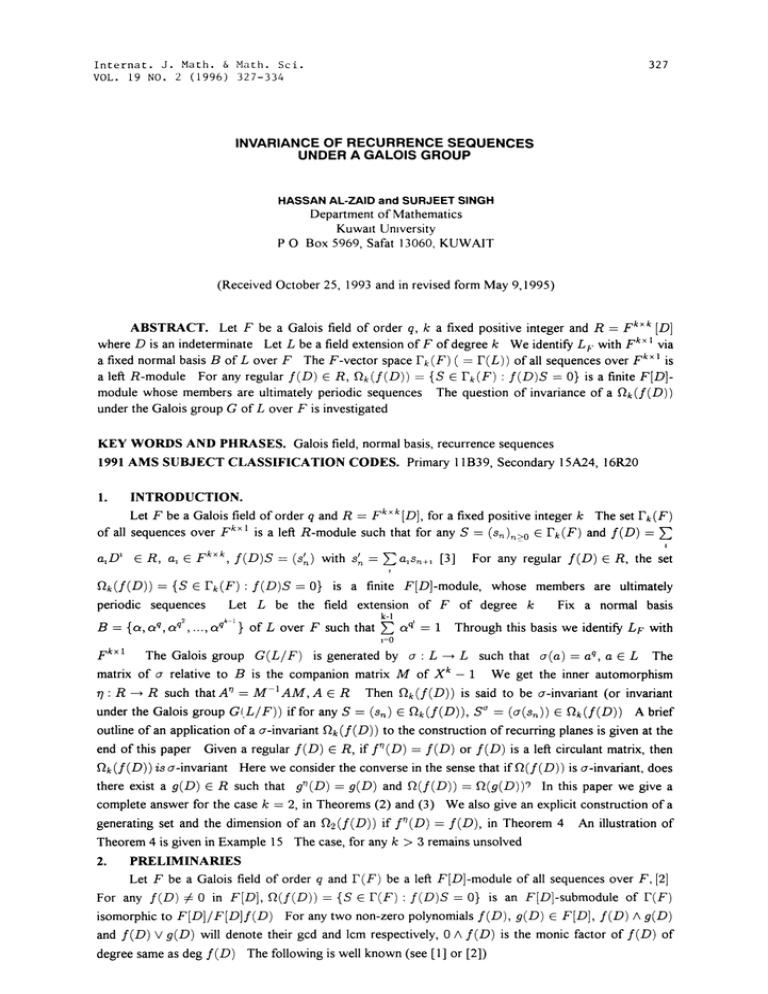
Internat. J. Math. & Math. Sci.
VOL. 19 NO. 2 (1996) 327-334
327
INVARIANCE OF RECURRENCE SEQUENCES
UNDER A GALOIS GROUP
HASSAN AL-ZAID and SURJEET SINGH
Department of Mathematics
Kuwmt Umversity
P O Box 5969, Safat 13060, KUWAIT
(Received October 25, 1993 and in revised form May 9,1995)
ABSTRACT. Let F be a Galois field of order q, k a fixed positive integer and R- F kxk [D]
where D is an indeterminate Let L be a field extension of F of degree k: We identi L F with F k via
a fixed normal basis B of L over F The F-vector space Fk(F)
F(L)) of all sequences over F k is
alett R-module For any regular f(D) E R, fk(f(D)) {S I’k(F) f(D)S 0} is a finite F[D]module whose members are ultimately periodic sequences The question of invariance of a ftk(f(D))
under the Galois group G of L over F is investigated
KEY WORDS AND PHRASES. Galois field, normal basis, recurrence sequences
1991 AMS SUBJECT CLASSIFICATION CODES. Primary 11B39, Secondary 15A24, 16R20
INTRODUCTION.
Let F be a Galois field of order q and R
of all sequences over F
1.
a,D
R, a
fk(f(D))
{S
F k, f(D)S- (s’) with
B
{a,
s’
asn+, [3]
The set I’k(F)
For any regular f(D)
R, the
set
Fk(F):f(D)S =0} is a finite F [D] -module, whose members are ultimately
periodic sequences
a q, a q2
Fkk[D], for a fixed positive integer k
Let L be the field extension of F of degree k
Fix a normal basis
k-I
q-I
q’
a
1 Through this basis we identify Lv with
} of L over F such that a
’
!=0
F kxl
The Galois group G(L/F) is generated by a L
L such that or(a) a q, a L The
matrix of z relative to B is the companion matrix M of X k 1 We get the inner automorphism
R such thatA ’ M-1AM, A R Then k(f(D)) is said to be cr-invariant (or invariant
r/: R
under the Galois group G.L/F)) if for any S (sn) f(f(D)), S
(cr(s,)) k(f(D)) A brief
outline of an application of a cr-invariant fk(f(D)) to the construction of recurring planes is given at the
end of this paper Given a regular f (D) E R, if f’ (D) f (D) or f (D) is a left circulant matrix, then
f(f(D)) is a-invariant Here we consider the converse in the sense that if(f(D)) is -invariant, does
there exist a 9(D) R such that 9’(D) 9(D) and (f(D)) f(9(D)) In this paper we give a
complete answer for the case/ 2, in Theorems (2) and (3) We also give an explicit construction of a
generating set and the dimension of an f2 (f(D)) if f’(D) f(D), in Theorem 4 An illustration of
Theorem 4 is given in Example 15 The case, for any k: > 3 remains unsolved
PRELIMINARIES
Let F be a Galois field of order q and F(F) be a lef F [D] -module of all sequences over F, [2]
For any f(D) =/= 0 in F[D],
isomorphic to F[D]/F[D]f(D) For any two non-zero polynomials f(D), 9(D) F[D], f(D) A 9(D)
and f(D) V 9(D) will denote their gcd and lcm respectively, 0 A f(D) is the monic factor of f(D) of
degree same as deg f(D) The following is well known (see [1] or [2])
2.
328
H AL-ZAID AND S SINGH
THEOREM 1. For any two non-zero polynomials f(D), g(D) in F[D]
(i) (f(D)) + f(g(D)) f(f(D) V g(D))
(ii) f2(f(D)) 3 f(g(D)) f(f(D) A g(D))
(iii) f(D)f’l(g(D)) f(a(D)/d(D)), where d(D) f(D) / (D)
For a fixed positive integer k, we consider R Fkk[D] F[D] kk Let L be the field extension
of Fofdegree k and a be the F-automorphism of L given by a(a) a q, a E L We fix a normal basis
B
{cr, aq,
aq
k-!
’
} of L over F satis,ing
a q’
By using this we identifi] L with F
1
Then
I--0
Homt.. (L, L)
F
and a is given by the k x k-matrix
the companion matrix of X k
For any A
0
1
0
0
0
0
1
0
0
0
1
0
0
0
1
0
1 Then
0
0
1
0
0
1
0
1
0
0
0
0
0
0
1
0
[a,:] E R
0-22
a32
a23
a33
a2k
a3k
a21
a31
M -AM
[b,]
ak2
l_ a12
where b,
a,+l 3+1,
-]-
LEMMA 1. For A
ak3
a13
akk
alk
akl
all
1, j + 1 are positive integers modulo k. The following is immediate
[a,3] R, M -1 AM A iff
al
ak
0,2
al
akak-2
ak
ak-1
a,’2
a3
ak
al
A
for some a, F[D].
For any A R, A ’ denotes M-IAM If f(D) R is regular, then the bound of f(D) is
the smallest degree monic polynomial d(D) F[D] such that Rd(D)c_ Rf(D); f’(D) R is
such that f(D)f’(D)= d(D)Ik
f*(D)f(D), [3]. Further fk(f(D)) f’(D)fk(d(D)Ik),
RFtk(f(D)) gt(d(D)I) and g&(d(D)I) f(d(D)) 1, [3]. For any module N, N denotes the
direct sum of k copies of N.
3.
A a-INVARIANT 12k(f(D))
We start with the following
LEMMA 2. Let f(D), g(D)
Rf(D)
Rg(D).
R, both be regular
Then fk(f(D))
k(g(D)) iff
329
INVARIANCE OF RECURRENCE SEQUENCES UNDER A GALOIS GROUP
PROOF. Let d(D)
bound (f(D)),
generator of the F [D] -module
d’(D)
bound (g(D)) Let a sequence S E F(F) be a
f2(d(D)) By [3, Lemma (2 4)], the mapping
fl(d(D))’
R/Rd(D)
"
[g,(D)] R
[Q, (d(D)L,)]
E
R/Rd(D), A[g,(D)] [g,(D)S] is a left R-isomorphmm
Rf(D) Rg(D), by [3, Lemma (2 4) (iv)], f(f(D)) f’l(g(D))
Conversely,
Q(f(D)) Q(g(D)) By[3, Theorem 2 5],
such that for any
f(d(D)I,)
ie
Rfk(f(D))
Rfh(g(D))
f(d’(D)I,)
,
_
If
f(d(D)) ’ f(d’(D)) l
This gives d(D) d’(D) As (d(D)) k Qk(d(D)Ik) A(f’(D)-)
[f"(D)Q(d(D)I)]
flk(f(D) and )(g’(D)R) f(g(D)) As Rd(D) C_ f’(D)R and Rd’(D) g’(D)R, we get
f’(D)R g"(D)R However Rf(D) {h(D) R" h(D)f*(D) d(D)R} (see [3, Lemma (2 2)]
As d(D) d’(D), it gives Rf(D) Rg(D)
PROPOSIT|ON I. For any regular f(D)
R, the following are equivalent
(i) fl(f(D)) is a-invariant
(ii) f(f(D) Q(f’(D))
(iii) Rf(D) Rf’(D)
PROOF. For any S (s,) Fk(F), let S
(a(s,)) (gs,) Obviously S Q(f(D)) iff
S
Q(Mf(D)M -) Thus Q(f(D)) is a-invariant ifff(f(D)) f(gf(D)g-) By Lemma
3, fk(f(D))-f’lk(Mf(D)M -1) iff Rf(D)-R(Mf(D)M -) iff RM-lf(D)M=Rf(D) iff
f(f’(D)) f(f(D))
The above proposition shows that if Rf(D)= Rg(D) for some g(D) R satisfying
gn(D) g(D), then (f(D)) is cr-invariant Is the converse true9 We investigate this question
LEMMA 3.
Let f(D)
R be regular such that Rf(D)
Rf’(D), let f(D)
Xf’(D) The
following hold"
(i)
det(X)
(ii)
There exists g(D)
A
g(D)
1
R, A’
R such that 9’(D)
g(D) and Rf(D)
Rg(D) iff for some invertible
AX
PROOF. (i) is obvious Let g(D) exist, then g(D) Af(D) for some invertible A
g’(D), gives AXfO(D) A’f’(D) Hence A AX. The converse is obvious.
R Then
LEMMA 4. Let f(D) and X be as in Lemma 3 Let X be obtained from X by applying the
cyclic permutation ,k (1,2, 3, k) to the columns of X Then some k-th root of unity, in some field
extension of F, is a characteristic value of X
a.
PROOF. Let f(D)
[a3], X
[x,3].
The equation f(D)
Xf’V(D), gives
k
a*.Y
E
:r’zul2u+ l,3+
u=l
where u + 1, j + 1 are least positive residues modulo k
equations in a. By arranging a.’s in the order
all, a21,
we get the coefficient matrix, the k x
akl, a12, a22,
k--matrix
This is a system of k homogeneous linear
ak2,
330
H AL-ZAID AND S SINGH
I
0
-X
I
0
0
0
-X
0
0
0
0
0
0
0
0
0
0
0
C
0
-X
I
I
where I is the k k-identity matrix As I and X commute, C as a matrix over
has determinant ! (X )k So for some matrix C’ over F[X’, 1],
CC’
diagkk[I-
F[X’X,I] c_ F’[D],
(XX) k, ..,I- (XX)].
By taking determinant over F[D], we get det(C)det(C’)
[det(I-
(xA)k)] k
As C is singular,
we get
det(I- (XX) k)
0.
This completes the proof
COROLLARY 1.
For k
2, under the hypothesis of Lemma 4, X-
a
b
-b
c
with
ac+b 2- 1
PROOF. Now X x
XllX22
Xl2X21
x
x2
x22
As 1 or
x21
1 is a characteristic value of X
a, and by Lemma 3
1, the result follows
THEOREM 2. Let F be a Galois field of characteristic p 2 Ifa regular f(D) E R F22[D]
is such that 122(f(D)) is invariant under a, then f2(f(D)) f2(g(D)) for some g(D) R satisfying
g(D)
g(D)
PROOF.
a
X
b
with 0 :/=
b]
c
det(A)
By Proposition
Then f(D)=Xf’(D), for some
Rf(D)-Rf’(D)
a12
R satisfying ac + b
1 In view of Lemma 3 we find an A
R
[all
I_ a21
F such that A n
AX,
a12
CaseI. b=O. ThenA=
all
0
1
0
a
a22
e
a21
b
a22
c
is a solution
Case II b -fi 0 By solving the system of linear equations it can be seen that
b-laall
all
b- all
b- C0/22
b- a22
(3 1)
0,22
with
det(A)
We now solve for all, a22, such that A
b-212alla22 aal ca2
R and det(A)
2alia22
1 Then (3
aal ca2
52
(3 2)
2) gives
(3 3)
INVARIANCE OF RECURRENCE SEQUENCES UNDER A GALOIS GROUP
331
O, (3 3) becomes
In case c
a (2a.2
1.
aal
By taking a 0 in F, this equation gives a._,2 E F[D]. Similarly if a 0, we can solve for
Let a 0 :/: c By multiplying (3 3) by c, and by putting Y ca22, we get
al and
a2
(Y-a )2
b
d"
Thisequationshowsthata,a,,_,2 shouldbe suchthat ai -c
d)(all + d)
(all
As c divided 1- b"
factors of 1 + b and 1
(1- b)(1 + b), and
1- b, 1
(34)
(ai-c).
+b
forsomed E
F[D]
Then
c.
are coprime, write c
CLC2,
with ct and c2
b respectively Put
a-d=c, a+d=c2.
-
Then
1
:(C
all
Then (3 4) yields
all
bd So that
ca22
Now 1
b
c2dl, 1
Cl).
+bd.
Y-ali
To be definite, take Y
1
:(c
C2) d
a,1
+ bd
1
b) +
-cl (1
+ b cld2 for some dl, d2 F[D]
1
c2 (1 + b)
Consequently
1
a22
: (dl + d2).
All that remains to prove is that the other entries of A are in F[D] Now (3 3) yields
ab
(aall
a22)
-i-
a,2(1 ac)
This
divides (aall a22)
This
theorem.
the
E F[D].
proves
Consequently b
b-l(all ca22)
We now consider the case of char F
(aall
gives
a22) + a22 b2
b-l(aall a22) F[D]
2
TItEOREM 3. Let F be a Galois field of characteristic 2 Let f(D) R
a b
1
E R satisfying ac + b
such that f (D) Xfn (D) for some X
b c
9(D)
tt satisfying Rf(D)
(I) b
Similarly
Rg(D) and f(D)
F22[D] be regular
Then there exists
g(D) iffone ofthe following holds
0
(II) be0, at least one of
s e F[D].
a
and c is non-zero, a/Xc=l, a=r and c=s for some r,
PROOF. Let Rf(D) Rg(D) with f(D) g(D) By Lemma 3 we get an invertible A in R
such that A n AX Let b 7 0 As in the proof of Theorem 2
332
H AL-ZAID AND S SINGH
a +b
b
and det(A)
b
(3 5)
ca.2.2
a,2.2
’2(aa + ca,2) a( # 0) E F. Thus
b2/3
aai + Ca722
F.
/3
a
(3 6)
Asac+b =l, aAb=bAc=l Then (3 6) yieldsaAc=l Further (3 6) yields
b2a3
[aa + (1 + b)a22]
This immediately yields a
R Similarly c
r for some r
1
0
Conversely if (I) holds, A
0]
a
s for some s 6
R
is a solution Let (II) hold. Then r A s
1
So for some
x,yR
rx
This gives
aa + ca2
b with al
EXAMPLE 1. Let char F
x, a22
X
det(f(D))=D(b12+b22) -0
D
D+I By Theorem
D+1
and a2(f(D))
b.
y. This solves for A.
2 Consider any b12,
f (D)
has
+ sy
b22
F[D] such that b12 + b22 :/: 0. Then
b22D + (D + l)b12 b12]
(D + 1)b22 + Db12 b22
Thus f(D) is regular.
Further f(D)=XfO(D) for
3 there does not exist any g(D) E R satisfying
D
f2(g(D)) although f2(/(D)) f22(f(D))
We now determine the dimension and the generating set of a f2(f(D)), if fn(D)
start with the following
f(D) We
LEMMA 5. Let f(D), g(D) and r(D) be any three non-zero members of F[D] such that r(D)
Let d(D) [g(D)/r(D)] A f(D). Then {S f(g(D)) f(D)S f(r(D))}
gt(r(D)d(D))
divides g(D)
PROOF. Let T be a generator of the F [D] -module 12(g(D)). Then for any s(D) F[D],
f(D)s(D)T f(r(D)) iff g(D) divides f(D)s(D)r(D) iff g(D)/r(D) divides f(D)s(D) iff for
d(D) [g(D)/r(D)] A f(D), g(D)/r(D)d(D) divides s(D). Consequently k {S E f(g(D))
f(D)S E f(r(D))} is generated by g(D)/r(D)d(D)T, so that K f(r(D)d(D)).
We now consider a regular A E R such that An= A. Then A
f(D)
g(D)l
g(D) f(D)
:
for some
0 Further we put
f(D) g(D) det(A); clearly
f(D), g(D) F[D]. We write
d(D) f(D) A g(D), dr(D) f(D) A A and dg(D) g(D) A A. As df(D) divides f(D) and
f(D) g(D) clearly d/(D) divides d(D) 2. So that (dr(D) V rig(D)) divides d(D) Obviously d(D)
divides df(D) A d(D) Consequently d(D) 1 iff dr(D) 1 dz(D) Write f(D) fl (D)d(D),
g(D) g(D)d(D). Then fl(D) A g(D) 1, gives f(D) A (f(D) g(D) ) 1 So that
dr(D)
f(D)d(D) A d(D)2(fl(D)
d(D)(fl(D A d(D)).
g(D) 2)
333
INVARIANCE OF RECURRENCE SEQUENCES UNDER A GALOIS GROUP
Consequently di(Di A d,j(D)
d(Dl(g(D) A d(D))
We
these results in the following
collect
di(D) d,t(D [df(D)d,iD)]/d(D)
9(D)
LEMMA6. ForA- If(D)
Similarly
d,j(D)
d(D)
Further
V
[g(D)
f(DI A g(D)
O)
dr, D)
(il)
diD)= iff df(DI
(ii)
df(D) V d,(D)
df(D) A d,iD
d,(D)
and
df(D) V d,(D) dvides d(D)-’
[df(D)dqID)]/dID)
We now prove the theorem that describes generators and the dimension of a f,_(A) with A
A
Here AWrite
d(D)
d(D) f(D) A
If,(D g’(D)]
f(D)g(D) f(D)g(D)
Zx
f(D) A/k So for some#, #’, ,A’
det(A’) By(2 10), g(D) A A1
F[D]
(D)+ AAt
(3 7)
g(D)
#’fl(D)+ A’A
(3 8)
d (D)
(#- #’) A/’1"
(3 9)
ft (D)
#g
Let
We shall use the above expressions and the other previously given notations in the subsequent results
LEMMA 7. Let T1 be a generator of the F [D] -module (d(D)) Then for
f (D)
9 (D)
9 (D)
f (D)
fz(A’)
#T
det(A’) A1, f22(A’) C_ "([1) 2xl Let T be a generator of the F [D] -module
a(A1) Let S2 Ea2(A’) NowS1 =s(D)Tforsomes(D)eF[D] andIl(D)S1 -91(D)S
and gl(-D)Sl
II(D)S2 By (3 7) II(D)Sl II(D)(s(D)T) 91(D)(s(D)T) So that
91(D)(S +.s(D)r) 0 This gives
Consequently S
s(D)T Similarly we also get S
fs(D)T So that s(D)(/- t’)T 0
Consequently A1 divides s(D)(#- #’) As dl(D) (#- #’) A At, we get A1/dl(D) divides s(D)
s(D)T
is in (A’) Thus 9t(A’) is
Conversely if A1/dl (D) divides s(D), it is immediate that
las(D)T
T1
the cyclic F [D] -module generated by
where T1 --[A1/dl(D)]Tisageneratorof(dl(D))
PROOF. As
THEOREM 4. Let A-
f (D) 9(D)
9(D) f(D)
f22(A)
F[D]
(D)
d(D) f (D) 91(D)]
91
f (D)
T
#T
R be regular Then
0
F[D] T’
Where T and T’ are generators of the F[D]-modules Q(dl (D)d(D)) and f’t(d(D)) respectively Further
dim(f2 (A)) deg(dl (D)d(D)) --t-- degd(D)
&/d(D) So by (3 9) dl (D)d(D) divides A Consequently by Lemma 5
(dl(D)d(D)) {S f2(A): d(D)S f2(dl(D))} Let T be a generator of the F [D] -module
ft(d(D)d(D)), then T1 d(D)T is a generator off(dl(D)) Given
$1
gt(A’), by (2 11), d(D) S
s(D) T1t.tT s(D) EF[D]
d(D) S
PROOF. Now A1
S1]
334
H AL-ZAID AND S SINGH
s(D)TI E f2(d(D)) Consequently S f2(d(D)d(D)) Furthermore we get
d(D)S So that S.,. + #S f2(d(D)) Hence
s(D)#T
Thus d(D)S
d(D)S.,.
with
St
a(d,(D)d(D)), S’
immediate that
_
#S + S
$2
n(d(D)) So that n2(A) _C f[D]
F[D]
(A)
T
#T
@ F[D]
F[D]
#r +
It is now
T’
The last part is now obvious
EXAMPLE 2. Let F be any Galois field of characteristic 3,
A_(D+2)[f(D) f9(D)]
(D)
g(D)
with
f(D)=2Dg+2D, 9(D)=Dg+D+I
In ’the notations of Theorem 4, d(D)=(D+2),#=#’=I, Zx=(D+2)2(D2+D+2),
/’x
D + D + 2, d l(D) (#- #’) A ’/1 D2 + D + 2 So that d l(D)d(D) D3 + D + 1 The
impulse response sequence T in (dl (D)d(D)) is of period 8, and its initial cycle is
00102212.
Theorem 4 gives that
2c+d
(A) consists of all sequences of least periods, factors of 8, with first eight terms
2b+d
2a+c+d
b+c+d
a+b+2c+d
with a,b,c,dF.
a+2b+c+d
a+d
2a+b+d
2a+b+d
We end this paper with a brief outline of an application of the cr-invariant sequences to recurring
planes A recurring plane over a Galois field F is a matrix, ,4 [a3] over F, indexed by the set of
natural numbers and for which there exist positive integers p, q satisfying a3 a+p. a,:l+q for all i, j
Any such ordered pair (p, q) is called a period of the plane Any consecutive k rows of A constitute a
matrix A
[a], s _< _< k + s 1, j _> 0. Each column of A being a member of F k 1, we can regard
A’, a sequence in r(F) Given a regular J’(D) E Fkk[D], call a recurring plane a row(f(D))-plane,
if every submatrix of A constituted by any k consecutive rows of A, is a member of fk(f(D)). Given an
J’(D) such that (f(D)) is cr-invariant, each s f(f(D)) gives a row(J’(D))-plane A [a,] whose
i-th row equals an s-th row of S if
s(mod k) The set of these planes can be easily seen to be closed
under component-wise addition, shifts of rows, and of columns Their detailed study will be done in
some later paper
ACKNOWLEDGMENT. This research was partially supported by the Kuwait University Research
Grant No SM075 We thank the referee for his valuable suggestions
REFERENCES
[1] LIDL, R and NIEDERREITER, H, Finite fields, Encyclopedta of Mathemattcs and Its
Apphcatlons, 20, Addison Wesley Publishing Co, 1983
[2] SINGH, S, A note on recurring sequences, Lmear Algebra Appl., 104 (1988), 97-101.
[3] SINGH, S, Recurrence sequences over vector spaces, Lmear Algebra Appl., 131 (1990), 93-106


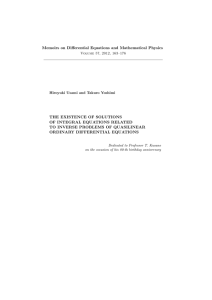
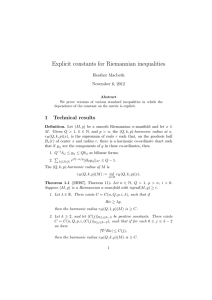

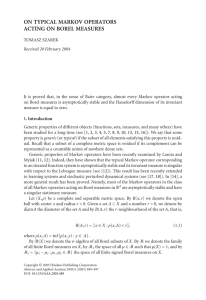
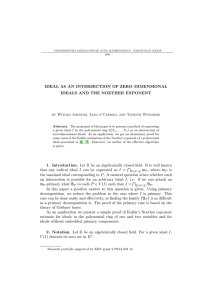
![5.5 The Haar basis is Unconditional in L [0, 1], 1 < 1](http://s2.studylib.net/store/data/010396305_1-450d5558097f626a0645448301e2bb4e-300x300.png)


